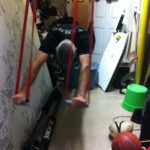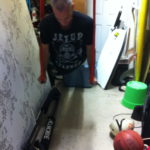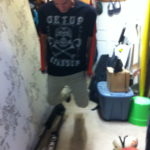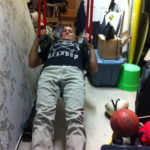Chronicles of an Old Guy on Training
I have recently been hit up on training and how I train for bouldering. Let me first say I am not a doctor, a nutritionist or a certified trainer. What I will say is that I do try to gleen as much information from smarter and stronger people to develop a plan of attack. Most of you have read my blogs and know my history, but for those that have not here is a quick recap: I am a husband and a father of two awesome boys (Luc and Enzo). I am 48 years old. I started climbing about 23 years ago. I have taken a few breaks from climbing during this time to tackle several sports, racquetball teaching pro, golf junkie, and Stand Up Paddle competitor. I am hyper competitive and find if I decide I want to do something I focus all my attention on it, usually to a point that I eventually burn myself out. That is the cost of an obsession. I have come to terms with this issue, thus my climbing tends to get stifled with these long breaks. The last break was 4+ years.
Sorry to bore you with all that information, just thought it might help qualify who I am and where I have been. OK, Training, what does this mean to me and how do I approach it? I break my plan into four parts, diet, general fitness, bouldering on plastic and setting an outside goal (a project I am shooting for).
Diet
My sole objective here is to shed weight to improve my strength-to-weight-ratio. After climbing for 23 years I have found where my weight range should be during training and when I head to send my projects. These usually are not the same as if I try to stay at these super light weights I find injury and illness are eminent. I usually train about 3-5 lbs heavier then my target sending weight. This also helps me psychologically as I feel lighter and stronger when I go outside.
What do I eat? Well as I said I am not a nutritionist, this is just what I have found that works and I can sustain on a daily basis. You need to build a plan you can sustain or you will find it easy to cheat or deviate from the goal.
Here is a standard weekday for me in regards to meals:
Breakfast
6-8AM Coffee – A few cups (an addiction, sorry I love coffee)
10:30 Greek Yogurt with raw almonds and Kashi cereal mixed in.
Lunch
12:00-1:00PM Rather than eat at lunch I go to the gym for my general fitness training at P.I.T. I will address P.I.T later and why I go there and the benefits I have received from training there. I also feel much better the second half of the day if I workout at lunch, no 2pm crash.
Post Lunch Meal
2:00PM Usually another yogurt as noted above or some type of salad loaded with eggs or some protein source for recovery.
Snack
5:00PM Usually by the time I get home from work I am craving more calories, veggies, fruit or sometimes pretzels. I try to be good on the snacks, but I can honestly say not too disciplined there. I get more strict the week I head for my projects.
Dinner
7:00-7:30PM I usually mix this one up. I eat a ton of salads and try to add a protein source (eggs, salmon, tofu). I will also do pasta one maybe twice a week and grilled fish if possible.
Wine and Beer
I know this will contradict many of the items I preach, but I do believe there needs to be a pay off for all your hard work. You can choose what that payoff is, I like wine. I do not drink five glass, just one to chill and enjoy my meal. Mental health therapy. *please note I am not suggesting you should start drinking especially if you are not of age. I am just telling you what I do on occasion. I try to eliminate this the week I am heading to send my project(s).
All of this is just to highlight what I do, this is not to suggest what you do, but give you an idea how I achieve my weight goals. The key I have found with all of this through trial and error is portion control. You must shrink your stomach to achieve a feeling of fullness quicker. Once you start feeling full stop eating! Over time your body will adjust and this will feel normal. At that time you will start seeing the pounds drop off.
General Fitness
This may seem obvious, but after years of climbing and trying a variety of techniques to get better and stronger, it is my belief that including a general fitness program to your training routine will indeed make you a better climber. In the past I would just climb for hours at the gym and do almost no additional fitness training. I started with Crossfit in 2009 after seeing many of my paddle competitors started to gain speed at a rapid pace. I then moved on to a more well-rounded program called P.I.T. in Laguna Beach, California. What I like about PIT is the full body workout and the emphasis is more cardio. My contention is if my whole body is strong and my cardio fitness is good I will climb better. I can honestly say I am fitter at 48 than 38 or 28 for that matter.
I returned to climbing in March 2012, at that time I was just doing PIT 4-5 times per week. I am now going to PIT 3-4 times a week and I go bouldering at Truhold Climbing (where I am a course setter) 3-4 days per week. I will do some two-a-days where I train at PIT at lunch and hit Truhold after work. I am not too concerned about the fatigue I have when I get to bouldering on a two-a-day workout as I believe your body will start to adapt over time, only making you fitter.
The full body connection; I follow the philosophy that the body is a chain and one weak link means the chain is easily broken. This integration of the full body workout I believe helps keep all these supporting muscle groups strong and leaves me with fewer “weak links” in the chain. Please note my focus with this routine is heart rate. I am not looking to gain weight, just strength and cardio fitness.
Here are a few pics of some home exercises I do.
Bouldering on Plastic
Intensity and objectives: I do not care what you are doing running, swimming, paddling or even route climbing you need to bring both intensity and some objectives for each and every workout. This does not mean this has to be all work and no play. It just means you need a plan or road map for your training. I typically have four objectives when I go to train on plastic, body tension training, training for a project outside, endurance and movement training.
I train for body tension every time I climb, I try to continually focus on the connection between my feet and my fingers, connecting the chain between them. I do have a small wall at home I also compliment this by doing small circuits of posturing on bad feet and marginal hand holds. The idea is to maximize the load you can take on your feet to reduce the load on your fingers. You need to learn how to stand on the smallest of feet and still generate power. As you approach more difficult problems this connection will allow you to hang on to holds and do moves once seemed impossible.
For years I employed the Huber Brothers system training techniques with the supervision of my climbing mentor Rob Mulligan. I found system training to be the single biggest increase in my climbing abilities of all the different training techniques. System training can be monotonous, but for me the proof is in the pudding and I went from working V5 to sending V8-9 and even some V10’s in very few attempts.
When I reference training for a project outside that is exactly what I mean. I have the luxury of being a course setter at Truhold Climbing in addition I have a small wall at my house. I like to build project simulators at the gym and crux simulators on my home wall. I try to repeat these movements to increase my chances to succeed when I finally hit the rock.
For endurance training I just simply work on trying to do as many moves as possible. What? At home I try to set a movement goal i.e Typically I will do 20-25 move sequences and repeat these over and over again. I may set a goal like do 100 total moves. I usually tie this into a workout. This would be an example: 100 touches on Jump Rope, 10 squats, 15 second handstand, 1 minute plank and then do my 25 move problem. I will try to do five rounds of the work. At the gym I often use a system I picked up from my friend Kevin Riley, Kevin sets a total #goal in V points. An example of this is do 100 V points. Now you just climb and add the V grade problems you complete. If you climb 20 V5 you have earned 100 points (20*5). When you start 50 points may be more realistic. Warm up on 10 V1’s, five V2’s, five V3’s, etc until you reach the total. this is a fun way to don it as you can mix up how hard you want to climb. You can go light and work on volume or increase the intensity to reduce the number of problems, but push your power more. Either way you are getting in a lot of climbing and that is the goal.
The other way I do this is to focus on 3-5 problems that push me a bit. I will try to repeat these 3-5 problems (varying styles) in sequence with no rest. I try to see how efficient I can climb them. You can employ the V grade point system to measure your work load. An example is two V3’s and one V4 (10 point value per sequence), repeat this sequence five times for 50 points. Start noting how many points you accumulate every time you training to help determine how much work you are getting in every workout.
In regards to movement training I try to really focus on warm up on my balance and my connection to my feet. I find if I start this way it will directly affect how I climb the rest of the day. I use a variety of keys I have learned from my mentors, like quiet feet. The idea here is to place you feet without making any noise. What you will find is your foot placement will become much more precise. The second is to climb slow (five second lockoffs) and make sure I find my balance point for a move. I do not care the grade V0 or V5, I try to find how to position my body so I can reduce the power as much as possible. I try to always stay in balance, of course this is not always possible but it is a good practice. The last item is posturing as referenced in the system training section above.
Setting an Outside Goal
I always have some outside project that my mind is focused on. All my efforts indoors are built around sending that problem or problems when I get an opportunity to climb outside. My last trip to Bishop I hoped on Evilution a few times and now it has become some what of an obsession with me right now. I know for that problem I need to increase my pulling power, finger strength and body tension. I have set up a few devices at home to assist me in gaining these strengths. My hope is to build up my strength for the next 30-45 days and return to Bishop and give it a shot. I believe it will go down, now it is time to put in the work.
Good luck to you all in your efforts to send you projects and if you have any advice or would like to see more training type post let me know. I am happy to share what I have learned over the last 23 years.
SS
Category: Blog, Daily Workouts, Scott's Journey, Training
















Great post Sancho! Keep grinding bro!
Thanks JT for all your support and wisdom.